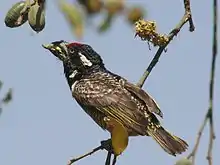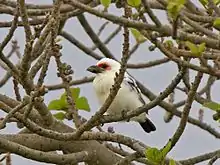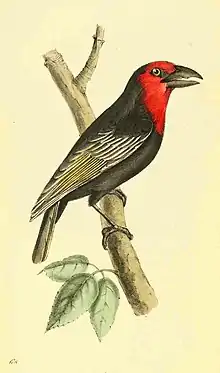Lybius
Lybius is a genus of African barbets from the family Lybiidae (formerly included in the Capitonidae and sometimes in the Ramphastidae). This genus ranges across sub-Saharan Africa.
| Lybius | |
|---|---|
.jpg.webp) | |
| Bearded barbet (L. dubius) | |
| Scientific classification | |
| Kingdom: | Animalia |
| Phylum: | Chordata |
| Class: | Aves |
| Order: | Piciformes |
| Family: | Lybiidae |
| Genus: | Lybius Hermann, 1783 |
| Species | |
|
12, see text | |
Description
The Lybius species are usually about 20–25 cm (7.9–9.8 in) long, plump-looking, with large heads, and their heavy bill is fringed with bristles. Almost all species in this genus are characterized by their red feathers on the head or around the eyes, but there is a great variety of morphology in this genus. There are barbets like the white-headed barbet that have no red on the head at all, and species like the double-toothed barbet with all red feathers on the ventral side of the body and head, but with only black on the dorsal side.[1] Pretty much all species in this genus have striking plumage, consisting of red, black, yellow or white colors.[2] These are also mainly solitary birds that eat fruit, insects and small vertebrates like lizards.[1]
Taxonomy
The genus Lybius belongs to the order Piciformes, which contains 8 families, including the woodpecker family.[1] A couple of decades ago, all barbets were thought to be of one family, but studies of mitochondrial DNA and DNA hybridization in the early 1990s have led to barbets being split into three families: Asian barbets (Megalaimidae), African barbets (Lybiidae), and American barbets (Capitonidae).[3] The family Lybiidae has a total of 42 species that occur throughout the continent of Africa from the tip of the Cape Peninsula to the fringes of the Sahara desert. Out of the 42 species in this family, Lybius contains 11 barbet species. These 11 species are the most frequently encountered group of African barbets.[4]
Extant species
It contains the following species:
| Image | Common Name | Scientific name | Distribution |
|---|---|---|---|
 | Banded barbet | Lybius undatus | Eritrea and Ethiopia. |
 | Vieillot's barbet | Lybius vieilloti | Senegal to Ethiopia |
.jpg.webp) | White-headed barbet | Lybius leucocephalus | Angola, Cameroon, Central African Republic, Chad, Democratic Republic of the Congo, Kenya, Nigeria, South Sudan, Tanzania, and Uganda. |
 | Chaplin's barbet or Zambian barbet | Lybius chaplini | South Central Zambia |
_(cropped).jpg.webp) | Red-faced barbet | Lybius rubrifacies | Burundi, Rwanda, Northwest Tanzania, and Southwest Uganda |
 | Black-billed barbet | Lybius guifsobalito | Cameroon, Democratic Republic of the Congo, Eritrea, Ethiopia, Kenya, Sudan, Tanzania, and Uganda. |
.jpg.webp) | Black-collared barbet | Lybius torquatus | Sub-Saharan Africa through Angola, Botswana, Burundi, Democratic Republic of the Congo, Kenya, Lesotho, Malawi, Mozambique, Namibia, Rwanda, South Africa, Swaziland, Tanzania, Uganda, Zambia, and Zimbabwe. |
.jpg.webp) | Brown-breasted barbet | Lybius melanopterus | Kenya, Malawi, Mozambique, Somalia, and Tanzania. |
.jpg.webp) | Black-backed barbet | Lybius minor | Gabon, Angola, Republic of the Congo and Democratic Republic of the Congo. |
 | Double-toothed barbet | Lybius bidentatus | Angola, Benin, Burundi, Cameroon, Central African Republic, Republic of the Congo, Democratic Republic of the Congo, Ivory Coast, Equatorial Guinea, Ethiopia, Gabon, Ghana, Guinea, Guinea-Bissau, Kenya, Liberia, Mali, Nigeria, Rwanda, Sierra Leone, South Sudan, Tanzania, Togo, and Uganda. |
 | Bearded barbet | Lybius dubius | tropical west Africa |
 | Black-breasted barbet | Lybius rolleti | Central African Republic, Chad, Sudan, and Uganda. |
Bird calls
Most of the Lybius species use duetting as a way to mark one's territory and to find a mate. Mates must have coordinating duets in order to be a proper match for each other, which means lone singers are very uncommon in the duetting barbet species. Duet songs are species-specific, and only paired duetting barbets can hold a territory, which is why lone singers are rarely seen. There are four known duetting species in this genus: Lybius vieilloti, L. leucocephalus, L. rubrifacies, and L. torquatus. The duetting of L. chaplini and L. undatus is unknown.[5] The behavioral significance of duetting probably involves sex recognition and the maintenance of a pair bond.[6]
Generally, the barbets in the duet will bow ceremoniously to each other while singing. In addition to bowing, certain African barbet species, like Lybius vieilloti and Lybius torquatus, will incorporate a snarl into their duet. The snarl might actually be how the duets are initiated in this species. When duetting, each bird will pick up the song from where the other bird left off. The time interval between when one bird ends the duet and when the other bird begins the song again is called the "auditory response time". Basically, the auditory response time is the minimum time required for the barbet to hear the notes and respond to them.[6]
References
- "Birds of Africa: Barbets." Archived 2013-12-14 at the Wayback Machine Birds of Africa: Barbets. N.p., n.d. Web. 03 Dec. 2013.
- "Lybiidae (African Barbets & South American Barbets)." Archived 2012-10-31 at the Wayback Machine Lybiidae (African Barbets & South American Barbets). N.p., n.d. Web. 03 Dec. 2013.
- "African Barbets." African Barbets. N.p., 7 Sept. 2004. Web. 03 Dec. 2013.
- "Africa’s Barbets." 10,000 Birds. N.p., n.d. Web. 03 Dec. 2013.
- Short, Lester L., and Jennifer F. Horne. "A Review of Duetting, Sociality and Speciation In Some African Barbets (Capitonidae)." Condor 85.3 (1983): 323-32. Web.
- Payne, R. B., and N. J. Skinner. "Temporal Patterns of Duetting in African Barbets." Ibis 112.2 (1970): 173-183. Web.